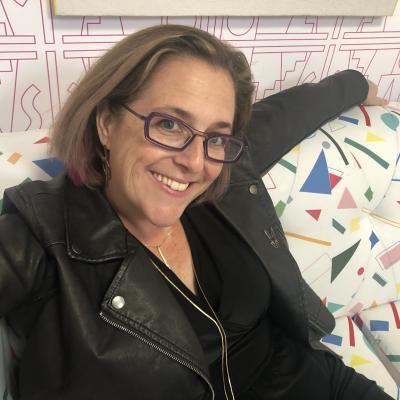Moody Faculty Spotlight | Erin Reilly
Published Spring 2024

Tell me about your work with artificial intelligence technology.
I have worked over a decade with AI to design for audience engagement. In one instance, IBM sponsored an 8-year project in which Twitter (now known as “X”) was scraped to build a natural language model on understanding fans’ motivation in language to identify engagement and loyalty. Since the early days, I recognized that these algorithms have an increasingly influence on our daily lives and aren’t necessarily doing the best job representing gender, racial and economic diversity. Thus, in my work, I encourage companies to standardize their data and training models avoid gaps and misinterpretations.
Here at Moody College, I'm pushing toward developing new AI models through the creation of a virtual being using generative AI (ChatGPT 3) to act in a “friend” capacity between humans and AI. In the last five years, the work has involved hosting a summit on Virtual Beings and developing one that is similar to a non-playable character (NPC) in video games. The NPC can provide a call and response scenario to engage an audience in conversation and over the course of the game, become friends with the user. Similar to the “Replica” AI agent deployed to address loneliness, but with a new understanding of the pitfalls of AI trying to navigate complex friendship scenarios, I am seeking to build a a social and emotional model for health-related conversations. Through the Texas Immersive Institute in collaboration with Dr. Hyekyun Rhee in the UT School of Nursing, I'm working on a project “Camp Cura” that gamifies a user to better understand how to identify, communicate and manage their chronic disease for young adults.
When UT President, Jay Hertzel, declared 2024 the Year of AI, I agreed to create a new class that teaches the use of AI in the creative workflow. Students will learn how to use generative AI tools to examine how AI can enhance and augment human creativity in various domains such as art, music, writing, and design. They will also critically analyze the ethical implications and societal impacts of AI-driven creativity. By the end of the course, students will be equipped with the knowledge and skills to harness the power of AI to push the boundaries of human creativity.
Do you think all educators should be experimenting with AI and its implications in communications field? Why?
Yes! Instructors need to experiment with the tools to better understand the implications of how it will change the way we live, learn, and work. We should have a growth mindset and her current work on a book chapter due out in next year through Rutledge entitled, “Remix Culture and the Age of AI,” features interviews from top creatives in the media industries who have taken this experimental approach to their own work.
How have you gotten students involved in using AI?
I have collaborated with graduate students, holding weekly research meetings to explore Virtual Beings and the use of AI in developing them. This research was shared with a wider audience at a 2-day event, Innovators Roundup. I also advocate for experiential instructional approaches to fill knowledge and skills gaps, and the Creativity in AI class is helping do just that!

